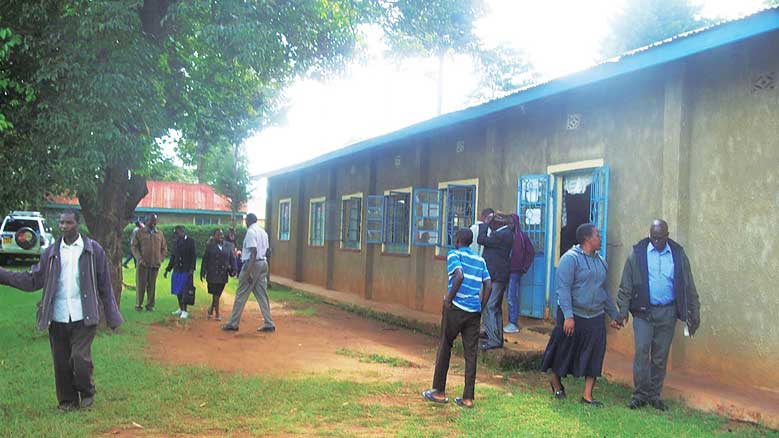
My wife, Gladys Kamonya, a Kenyan, and I, an American, are members of both Bethesda (Md.) Meeting of Baltimore Yearly Meeting and Lumakanda Friends Church of Lugari Yearly Meeting in Kenya. When you look at Friends World Committee for Consultation’s (FWCC) total of Friends worldwide, be sure to subtract two from their total since we are counted twice. I must admit that I prefer the silent, unprogrammed worship of Bethesda Meeting. On the other hand, as a child, my parents sent me to an Episcopal church. The programmed worship of that church with singing, prayers, preaching, offering, announcements, marriages, and funerals, was similar to Lumakanda Friends Church. Both sing the same songs: “Stand Up, Stand Up for Jesus”; “Onward, Christian Soldiers”; “Rock of Ages” (for funerals); and all the same Christmas carols. The difference is that most of the songs here are sung in Swahili.
The differences between the Quaker church and other churches, though, are important. One major difference is that there are many female preachers in Kenya, contrary to the other churches in the area (which include Pentecostal Assemblies of God, Seventh-day Adventists, the Salvation Army, Deliverance Church, the Catholic Church, and the Muslims). During the 2008 post-election violence, 32 pastors—all male—asked Friends Church Peace Teams (Kenya) to conduct a peace seminar at the local internally displaced people’s camp. Three of the four presenters were women. This astounded those pastors who commented, “We didn’t know women could preach so well.” Women preach at Lumakanda one, two, or even three times per month. Gladys’s sister, Josephine Kemoli, is the pastor at Pendo Village Meeting, one of Lumakanda Friends Church’s other village meetings.
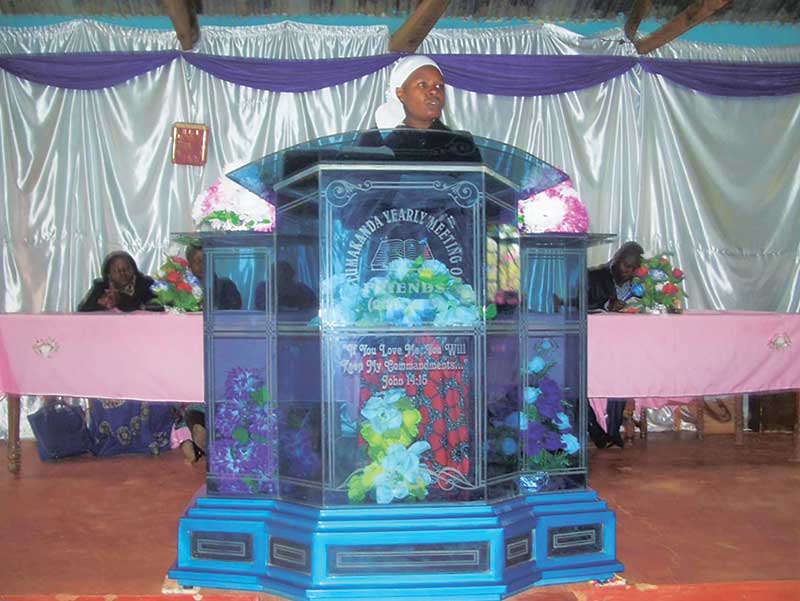
Women preach at Lumakanda one, two, or even three times per month.
Long ago, I learned that theology is quite fluid and changeable while structure is not. Consequently, the Quaker structure is similar everywhere and has not changed much since the original Quaker missionaries came in 1902. There are yearly meetings, quarterly meetings, and monthly meetings. In Kenya, there are village meetings under the monthly meetings because a church needs to be within walking distance of the parishioners. Lumakanda’s monthly meeting is composed of four village meetings. We attend the local Lumakanda Village Meeting, which is about three blocks from our house.
Much of the teeth gnashing that happens among American Quakers sounds strange in Kenya. Lumakanda Village Meeting has over 600 members or official attendees, including over 200 children. The Sunday school, where we send our six grand-generation children, has 60 to 80 younger children attend every Sunday. There is another class for the older primary school students. High school students mostly attend the service.
To join the Quaker church each person has to join a study class, called “Book One” or “Book Two,” which lasts about an hour with instruction after service each Sunday for a year. When a person moves through these two years of study, they become a member. Every year there are about six to ten people in each class. In contrast to the United States and Britain, the Quaker Church in Kenya is growing. Likewise, as the church is filled with younger people, there is no worry about the church being attended only by old people.
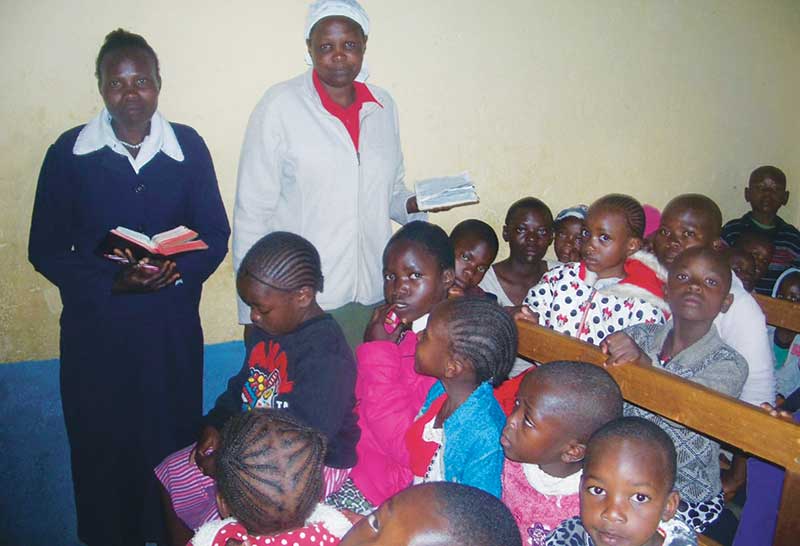
In contrast to the United States and Britain, the Quaker Church in Kenya is growing. Likewise, as the church is filled with younger people, there is no worry about the church being attended only by old people.
About 100 people attend the morning village meeting service every Sunday. There are three rows of benches facing the podium; there is no altar as in other Christian churches. The women mostly sit on the left side, and the men mostly on the right side. The younger people tend to sit in the middle. Gladys and I are unusual in that we sit together in the middle row. After 12 years in the church, I know many of the people, but because husbands and wives sit on opposite sides, even when I know both, I may not realize that they are married.
In addition to Sunday school, the church is divided up into three groups: (1) Young Friends, which includes people from 18 to 35 years of age, the age range American Friends would call “young adult Friends”; (2) United Society of Friends Women (USFW); and (3) Quakermen. Each group has its own officers: clerk, recording clerk, and treasurer, plus their assistants. The village meeting and monthly meetings have comparable lists of officers. Elections are every two years, and when the new officers are introduced, the front of the church is overflowing with them. They are then approved by the congregation, welcomed, and blessed with a prayer.
After 12 years in the church, I know many of the people, but because husbands and wives sit on opposite sides, even when I know both, I may not realize that they are married.
Fundraising for the church and its activities is multifold. There is an offering each Sunday that does not produce much, usually about $20 to $25. Then there is the monthly 10 percent tithing that raises significantly more. There are also specific fundraisers called harambee, meaning “let us pull together.” This is used for many purposes, for example to fill the allocation due to Lugari Yearly Meeting; to make some improvements to the church (this year they are tiling the floor, which will cost over $2,000); special fundraisers for people in need such as a student from a poorer family who needs school fees; medical expenses; to build or repair a house of a member; and so on.
A few years ago a well-liked pastor, Edward Muluya, wanted to get a master’s degree in theology. He needed $900 for the tuition. The church conducted a harambee for him and in one day they received $1,120. They gave him the extra for books and travel. Another interesting fundraising method is that when the bean harvest and later the maize (corn) harvest come in, farmers are encouraged to make an in-kind donation. Members give up to a 200-pound bag of maize so that the whole front of the church is filled. The harvest is then sold to support the church. Another time the church collected clothes for those parents and grandparents of limited means who were raising children or grandchildren.
Like meetings and churches in the United States, Lumakanda Friends Church rents out its space; since it is one of the largest halls in Lumakanda, this happens often. Another income-generating activity the church began some years ago was purchasing 100 plastic chairs (rented out at $0.10 per day) and a tent to hold 100 people (rented out at $20 per day); anyone may rent these for weddings, funerals, or other celebrations. Last year, after raising the capital through a harambee, the church put up three metal kiosks at the end of their property and now rent them out for $20 per month each. They are now planning to buy a fourth kiosk.
A major activity of the church is to arrange for weddings and funerals. When this happens, the church appoints a committee to make the arrangements for the event. Part of their charge is to raise about $2,000. Of course, the families involved contribute their share, but everyone in the church donates what they can. For a funeral, the amount needed includes the medical expenses that the deceased incurred before dying. The largest expense I have seen is $20,000 for a prominent Quaker woman who had to be air-evacuated to Nairobi before she died. In the United States, almost half the population cannot afford a $400 emergency expense. Here at Lumakanda Friends Church, everyone can “afford” a $400 expense because the church membership will raise the funds. Since Gladys knows the situation better than I, she is the one who decides and makes the contributions for both of us. We want to pay our fair share, but don’t want the church to become dependent on us. So far this has worked out well.
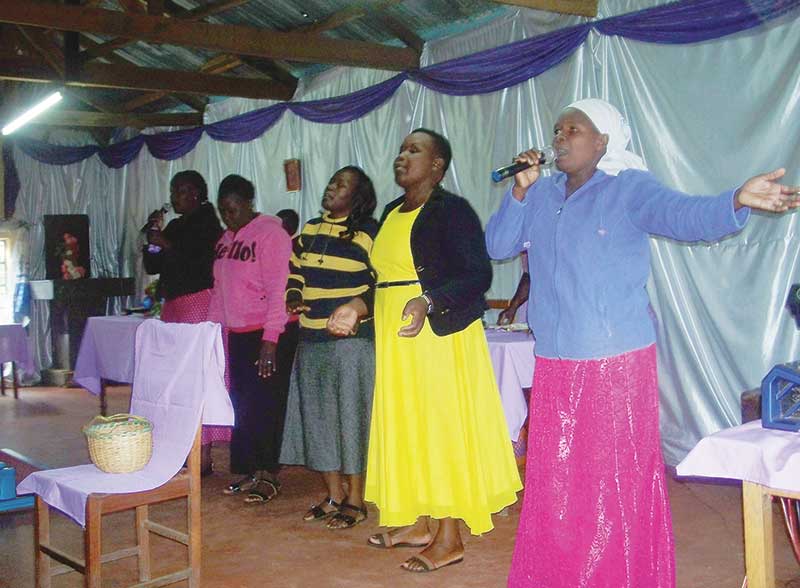
Lumakanda Quakers never discuss or worry about community, but the church is clearly a community. Since everyone lives near the town, there are frequently out-of-church interactions. We hire members of the church when we need some service: two members, for example, are veterinarians; another does Gladys’s hair; the clerk of the meeting cares for our bushes and trees; another has a team of oxen we hire when we need to carry sand, stone, or firewood.
As can be surmised from the description above, Lumakanda Quakers are firmly middle class. Many own plots of land. Since this is in a settlement scheme area, people were allocated about 20 acres of land that now sells at $7,500 per acre. When we built our house, we bought a very large tree for $250 from the then-clerk of USFW. This was sufficient to make all the rafters we needed for our house. Many of the members of the church are teachers, nurses, police, small business owners, and town property rental owners. Many are retired Friends who worked in places like Nairobi and have now returned to their plots near Lumakanda.
Lumakanda Quakers never discuss or worry about community, but the church is clearly a community.
What do I not like? Every five years there are elections in Kenya. Politicians come to the church and to funerals, where up to 1,000 people can be gathered, and, for a small donation to the church, are allowed to make a campaign speech. I am not the only one who is appalled by this activity. Moreover, in some cases this politicking divides the church into opposing sides: there have been yearly meeting splits in Kenya over politics. Another issue is that almost everyone in the church is of one tribe called the Luhya. Tribalism is the racism of Kenya and people can be intolerant. One wedding included a large contingent of relatives and friends from a different tribe in which the pastor spoke in the Luhya language for over 15 minutes, erroneously conveying that Quakers are only Luhya. While Lumakanda Friends Church is fairly well gender balanced, this is not true of Kenyan society as a whole nor of the Quakers at the yearly meeting level, which is almost exclusively male dominated.
Although there are three Asian Indians who work at a local quarry, I am the only mzungu (stranger, or white person) in town. So if you come to visit, in order to find our house, all you have to do is ask, “Where does the mzungu live?” I have been here for over 12 years, so at the church I am just part of the scenery. If I am treated in any special way, it is not because I am a mzungu but because I am elderly. As Americans who come to Kenya comment, Kenyans are always friendly and welcoming. In Swahili, the word mgeni means both “stranger” and “guest.” As is traditional for grandparents at this time, we are taking care of three grandchildren (ages three, six, and six), a grand-niece (five), and two grand-nephews (both 11). One of our daughters-in-law, the mother of two of these children, lives with us also.
Over half the world’s Quakers live in East Africa, affiliated with Friends United Meeting (FUM) in Kenya, Uganda, and Tanzania and with Evangelical Friends Church International (EFCI) in Burundi, Rwanda, and eastern Congo. I find that the division of Friends World Committee for Consultation into continents means that American unprogrammed Friends know little about Quakerism in Africa and do not visit at nearly the rate of FUM and Evangelical American Friends. FWCC Section of the Americas has a great intervisitation program for the Americas but this excludes Africa. I think this oversight should be addressed. Kenyan Friends will welcome visitors with their usual warm hospitality. Unprogrammed American Friends would greatly benefit from such an interaction.




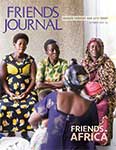

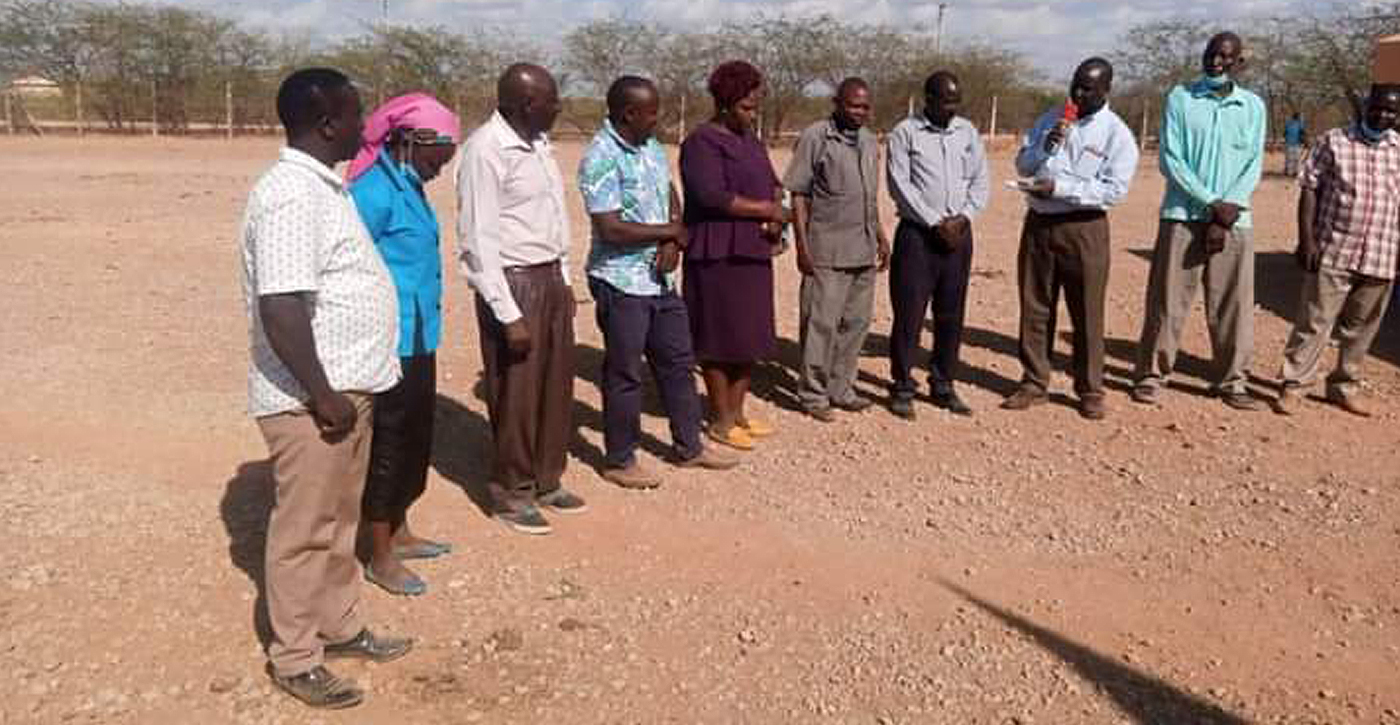
You have painted a true picture of Friends Church in Kenya. A nice piece and a true reflection of Friends Church in this part of the world.
As an “Unprogrammed American Friend” who has experienced the warmth and hospitality of Lumakanda and other Kenyan Friends, I support David Zaremka’s call for more intervisitiation. Yesterday was World Quaker Day, and I spoke in my meeting (Fairbanks, Alaska) about worshipping with Friends in Kenya. In particular, I recalled the joy of singing at Boruboru Church in Nairobi.
Thank you so much for this wonderful descriptive article about Kenyan Quakerism. I am totally ignorant of both African Quakers and the different “flavors” of Quakerism that exist. My daughter has traveled to African and wants to go back again. She has asked me to go with her, I hope to do so.
Wow! I get the insight of what goes on at Lumakanda Friends Church. Not much different from my Church, Malakisi Friends Church,in Bungoma….. Humbled to be part of this great Church.
Thank you so much for the information provided. Many of us are near Lumakanda but we do not know that they have such wonderful plans and programs.
There is much to be learnt from Lumakanda by a number of our Churches. Lumakanda in this part of the world is a role model. Being at the sub county headquarters, you are doing fine utilising the potentials you are accessable to. You can even do more. Keep it up Friends. You are a good letter to be read.
Bravo Gladys and Zerembka.
Such a great article.
Interesting that Husbands & Wives sit on separate sides…similar to what many Muslims do in Losque.
Amazing! How different from our small Great Falls, MT meeting with about 10 active members who mostly listen silently to a power that encourages us to live Love in all our affairs. Blessings from Starshine
Hi David.
I thought your article was a very illuminating and inspiring description or how a Quaker community can be.
I support your call for Friends from unprogrammed meetings, like ours in Southern Africa, to visit the Friends in Kenya, I have had he good fortune to visit Friends in Kenya, Burundi, Rwanda and DRC, and host visitors from Kenya and Burundi at the Quaker Peace Centre in Cape Town, These have all been very rewarding exchanges. I fully support more contact.
The Southern African Quaker Community is hosting the FWCC International gathering in Durban in 2023. I hope
many friends from East and Central Africa will be able attend, and even leave a permanent presence. The type of Quaker Community you describe would be most welcome in Southern Africa, and from my experience we can cooperate and have valuable exchanges
I remember being startled and offended by the political speeches made by Quaker candidates running for office after small donations in Kenya Quaker Churches. Little did I know at the time that this was common accepted practice in Kenya! It seems like one time the donation was soda for the congregation.